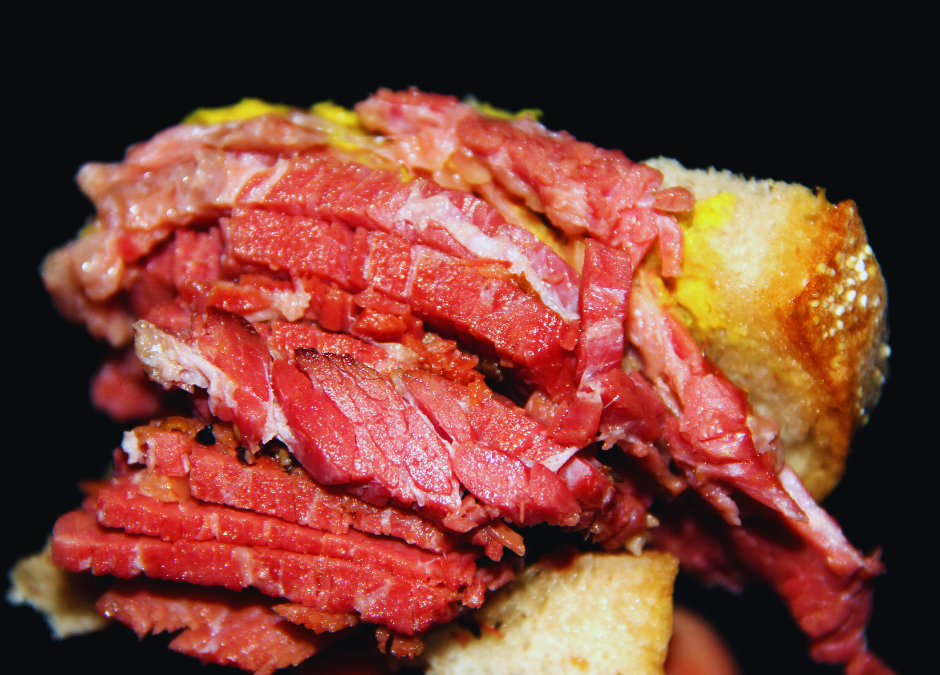How an Irish Invention Became Found a Home in the Jewish Deli
Go to a Jewish deli and you’ll find some of the world’s most amazing corned beef. Likewise, dine at a true Irish eatery or attend a St. Patrick’s Day event and there will be corned beef. Is it a Jewish staple that made it into Irish cuisine or a taste of the Emerald Isle embraced by the Jewish community? Or a bit of both?
What Is Corned Beef?
Contrary to what the name suggests, there is no corn involved anywhere in the making of corned beef. It starts with a beef brisket, a cut that comes from the lower chest of a cow (most often from the steer). A notoriously tough cut of meat, due to the prevalence of connective tissue, brisket is typically cooked at a low temperature for a number of hours to make it tender. In the southern United States, the tradition is to smoke or cook the brisket with little more than salt, pepper and garlic, though it’s not unusual for special rubs to be used.
To convert brisket to corned beef, it is cured and brined for anywhere from a week to a month. The brine typically includes pickling spices, garlic, brown sugar, salt and pink curing salt (also known as “Prague Powder”). In addition to adding a distinct flavor to the meat, the pink curing salt also gives corned beef its distinctive hue. Don’t confuse the pink curing salt with Himalayan pink salt, though—they are two very different substances. The curing salt also prevents bacterial growth and acts as a preservative.
Once the curing process is done, corned beef is typically boiled or slow-roasted in the oven. If the corned beef brisket is smoked, it becomes pastrami.
How Did Corned Beef Originate?
In Ireland in the early 1800s, beef was a significant export crop, due in part to the fact that it was too expensive for most of the Irish population. However, to prevent the beef from spoiling while in transit, it needed to be cured. The best available process to preserve meats at the time was salting. Meat would be packed in corn-sized chunks of salt, which led the process to be called “corning” and the product to be called “corned beef.” Interestingly, though corned beef was typically out of reach financially for most families in Ireland, when they came to the United States, they found brisket more affordable and brought the corning process with them.
There’s also historical evidence that indicates that Jewish butchers in Eastern Europe would use a salt-curing process to preserve certain meats, similar to the corning process.
How Did Corned Beef Become a Staple of the American Jewish Deli?
Around the beginning of the 20th century, large numbers of Irish and Jewish immigrants came to the United States, particularly to New York City, where they typically lived close to each other. It’s unknown whether it was an Irish butcher who influenced the local Jewish community or vice versa. The corned beef brisket appealed to the Jewish community for a number of reasons:
- The process did not conflict with Jewish dietary laws
- Because of the corning process, the meat could be stored without refrigeration
- The brisket, at least in the United States, was an affordable, plentiful and ultimately tasty option
Of course, corned beef also appealed to the mostly poor Irish immigrants because of its affordability and ability to be preserved without ice or refrigeration.
The Corned Beef on Rye—Classic Jewish Deli Fare
Historians disagree as to the origin of the mouth-watering corned beef on rye sandwich. Easterners contend that it made its debut at Reuben’s Delicatessen in New York City somewhere around 1914. Midwesterners argue that Bernard Schimmel, a chef at the Blackstone Hotel in Omaha, Nebraska, created the sandwich (now popularly known as a reuben) as a tribute to local grocer and card shark Reuben Kulakofsky. Proponents of the Omaha theory say that the sandwich sold at Reuben’s Delicatessen was merely roast beef, not corned beef.
Gutterman’s and Gutterman Warheit—Meeting the Funeral and Burial Needs of the Jewish Community for More than 130 Years
At Gutterman’s and Gutterman Warheit, with funeral chapels in New York and Florida, we have provided comprehensive funeral and burial services to the Jewish community for more than six generations. We understand the unique customs within each Jewish tradition and can offer guidance on any issue, from the structure of the memorial services or the choice of a casket or monument to the details of sitting Shiva or the preparation of a Yahrzeit calendar. We will also work directly with the Chevra Kadisha to ensure compliance with Jewish law in the preparation of the body.
To learn how we can help, send us an email or call us at one of the numbers listed below.
Gutterman’s & Gutterman Warheit — Where Relationships Matter
Family Owned and Operated Since 1892
Rockville Centre: (516)764-9400 | Woodbury: (516)921-5757 | Brooklyn: (718)284-1500
Boca Raton, FL: (561)997-9900 | (800)992-9262

